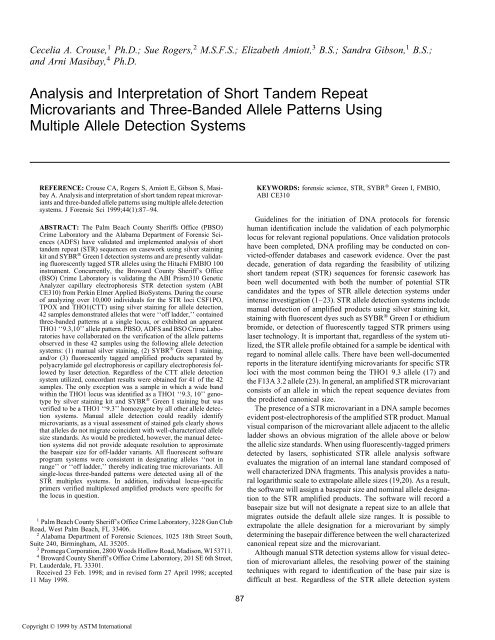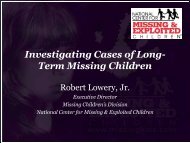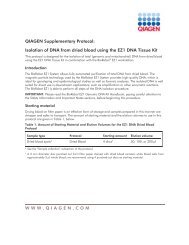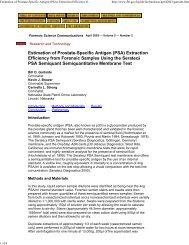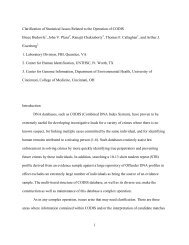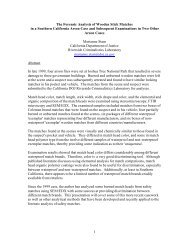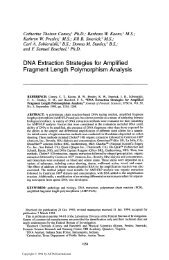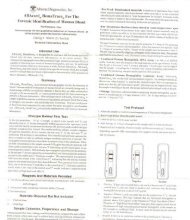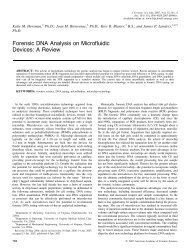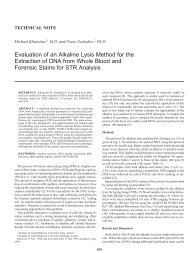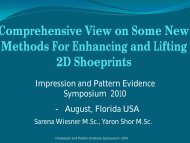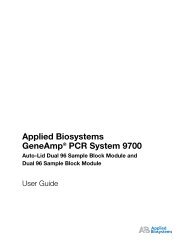Analysis and interpretation of short tandem repeat microvariants and ...
Analysis and interpretation of short tandem repeat microvariants and ...
Analysis and interpretation of short tandem repeat microvariants and ...
You also want an ePaper? Increase the reach of your titles
YUMPU automatically turns print PDFs into web optimized ePapers that Google loves.
CROUSE ET AL. • MICROVARIANTS AND ALLELE PATTERNS 89TABLE 1—Collaborative study summary.No. ObservedFMBIOSilver <strong>and</strong>PEObservation Locus SYBR Green CTTv† Ind. Primers† Power Plex† CE310†Three-b<strong>and</strong>ed patterns CSF1PO 1 1 1 N/D§ N/DTPOX 18 18 18 18 15THO1 1 1 1 1 1THO1 ‘‘9.3,10’’ genotype THO1 11‡ 9 10 10 9THO1 ‘‘10,10’’ genotype THO1 2 2 2 2 2Alleles outside bounds <strong>of</strong> allelic ladder CSF1PO 2 2 2 1 1TPOX 1 1 1 1 1THO1 4 4 4 4 2Alleles <strong>of</strong>f-ladder but within allelic CSF1PO 1 1 1 1 N/Dladder st<strong>and</strong>ards THO1 1 1 1 1 1* Numbers reflect total number <strong>of</strong> samples analyzed <strong>and</strong> confirmed for each detection method.† Fluorescently-tagged primers.‡ One <strong>of</strong> these ‘‘9.3,10’’ genotypes was confirmed to be a ‘‘9.3’’ homozygote by all fluorescent systems.§N/DNot done due to lack <strong>of</strong> DNA sample.FIG. 1—Polyacrylamide gel electrophoresis <strong>of</strong> 18 samples (A1–A18) amplified with Promega’s fluorescently tagged TPOX specific primers. Amplifiedproducts were detected using the Hitachi FMBIO 100 instrument. Unlabeled lanes contain the TPOX allelic ladder.ples that was confirmed using the CTTv multiplex system <strong>and</strong> theCSF1PO individual primer set (data not shown).Single-Basepair Differences Between AllelesInitial silver staining <strong>and</strong> SYBR ® Green I staining <strong>of</strong> the data-base <strong>and</strong> population samples detected 11 samples which may containa THO1 ‘‘9.3,10’’ genotype <strong>and</strong> two samples which may havea THO1 ‘‘10,10’’ genotype. The fluorescently tagged systemsreadily detected the one basepair difference confirming the pres-ence <strong>of</strong> a THO1 ‘‘9.3,10’’ genotype in 10 <strong>of</strong> the 11 samples. One<strong>of</strong> the DNA extracts appeared to contain a THO1 ‘‘9.3,10’’ genotypeby silver staining <strong>and</strong> SYBR ® Green I staining but usingfluorescently-tagged systems demonstrated a discrete ‘‘9.3’’ allelehomozygote (data not shown). The initial genotype call <strong>of</strong> a THO1‘‘9.3,10’’ heterozygote could be the result <strong>of</strong> the staining processwhereby amplified products may produce a wider b<strong>and</strong> pattern dueto the staining <strong>of</strong> both str<strong>and</strong>s <strong>of</strong> the DNA fragment. The advantage<strong>of</strong> fluorescently-tagged PCR primers is that only one amplifiedstr<strong>and</strong> is detected, thus providing more discrete b<strong>and</strong>s. Two sam-ples amplified at the CTT loci were subsequently analyzed by gelelectrophoresis <strong>and</strong> visualized with SYBR ® Green I <strong>and</strong> the silverstaining kit were interpreted as a ‘‘10’’ homozygote, both <strong>of</strong> whichwere verified using all fluorescent allele detection systems (datanot shown).Examples <strong>of</strong> THO1 ‘‘9.3,10’’ genotypes are shown in Figs. 3a<strong>and</strong> 3b. The ABI CE310 GenoTyper2.0 s<strong>of</strong>tware (Fig. 3a, panelsa through e) provide discrete peaks representing the one basepairallele difference in these samples at the THO1 locus. An example<strong>of</strong> a ‘‘9.3,10’’ THO1 genotype amplified with PowerPlex THO1primers is shown in Fig. 3b. The gel file from the FMBIO 100analysis (Fig. 3b—top, lane 3) clearly shows migration <strong>of</strong> a THO1double b<strong>and</strong> in the 9.3 <strong>and</strong> 10 allele position. The ‘‘9.3’’ st<strong>and</strong>ardfrom the Promega CTT kit was electrophoresed alone in lane 4 inorder to aid in the visualization <strong>of</strong> the ‘‘9.3’’ migration pattern.The doublet is also evident as two peaks representing the ‘‘9.3,10’’genotype in the FMBIO 100 electropherogram (Fig. 3b—bottom).The FMBIO 100 STaRCALL2.0 <strong>and</strong> ABI CE310 GenoTyper2.0s<strong>of</strong>tware basepair designations for the ‘‘9.3,10’’ genotypes indi-cated there was approximately a one basepair difference betweenthe two alleles.‘‘Off-Ladder/Not in Range’’ AllelesInterpretation <strong>of</strong> the laser-scanned amplified products by instru-ment s<strong>of</strong>tware is straightforward unless a microvariant is detected.In these cases, the microvariant is not assigned a nominal alleledesignation. In this study, amplified STR products that migratedbetween, above, or below the allelic ladder st<strong>and</strong>ards were detectedin ten samples. In order to discern the difference between an allelethat migrates between the default alleles versus an allele thatmigrates outside the allelic ladder default range, PBSO <strong>and</strong> ADFSprotocols have assigned the following nomenclature for such<strong>microvariants</strong>. A rare microvariant migrating between two alleleswithin an allelic ladder is recorded as the lower molecular weightallele designation followed by a ‘‘.x’’. An example would be ifan allele migrated between the 10 <strong>and</strong> 11 allele <strong>of</strong> the CSF1POallelic ladder, the allele would be designated a ‘‘10.x’’. Further,if an allele migrates above or below the defined allelic ladder, theallele is described as ‘‘’’ or ‘‘’’ than the nearest allele. Anexample <strong>of</strong> this would be an allele which migrates above the upper
90 JOURNAL OF FORENSIC SCIENCESFIG. 2—Capillary electrophoresis <strong>of</strong> six fluorescently-tagged TPOX three-b<strong>and</strong>ed patterns (compare Fig. 1 lanes 7, 16, 18, 12, 8 <strong>and</strong> 5 with panels2 through 7, respectively). AmpFlSTR Green I multiplex was used for amplification <strong>and</strong> the ABI CE310 for allele detection. The TPOX allelic ladderis shown in panel 1.bounds <strong>of</strong> the CSF1PO allelic ladder. In this case, the allele would ABI CE310 allele calls, that is, basepair sizing verified the numberbe assigned as a ‘‘15’’ allele.<strong>of</strong> <strong>repeat</strong> differences between the microvariant <strong>and</strong> the commonSeven DNA samples exhibited amplified alleles which migrated alleles identified in st<strong>and</strong>ard allelic ladders.above () or below () the designated allelic ladder size range An ABI CE310 electropherogram shows a sample (Fig. 4, panel(Table 1). Two samples were observed for the CSF1PO locus, one 6, arrow) that contains a CSF1PO allele ultimately designated asat the TPOX locus <strong>and</strong> four at the THO1 locus. Typical examples a ‘‘10.x’’ as it has migrated between the 10 <strong>and</strong> 11 nominal alleles.<strong>of</strong> alleles migrating outside an allelic ladder range are shown in The predicted size <strong>of</strong> this fragment was 298.1 bp which is twoFig. 4. Using the ABI CE310 GenoTyper2.0 s<strong>of</strong>tware, Fig. 4, panel basepairs greater than the 10 allele, thus indicating this fragment2 shows the results from a sample with a THO1 allele migrating is most likely a ‘‘10.2’’ allele. Figure 5A1 (top panels) showsbelow the THO1 allelic ladder (arrow) indicating an ‘‘<strong>of</strong>f-ladder’’ this same sample amplified using primers from the CTT multiplexallele. As per PBSO <strong>and</strong> ADFS nomenclature, this THO1 b<strong>and</strong> followed by SYBR ® Green I staining (lane 2). The CSF1PO 12was designated as a ‘‘5’’ allele. This ‘‘5’’ THO1 allele was allele clearly lines up with the 12 allele in the ladder whereasfound to have a basepair size <strong>of</strong> 162.8 that would indicate a frag- the faster migrating fragment does not align with any b<strong>and</strong> in thement one <strong>repeat</strong> size smaller than the THO1 ‘‘5’’ allele. A TPOX CSF1PO allelic ladder agreeing with the films from silver stainingamplified allele migrating <strong>of</strong>f-ladder is shown in Fig. 4, panel 4 <strong>and</strong> ABI CE310 ‘‘10.x’’ allele designation. This sample was also(arrow). The genotype <strong>of</strong> this sample was recorded as ‘‘11,13’’. amplified using the fluorescently-tagged CTTv multiplex (Fig.The higher molecular weight allele had a basepair size <strong>of</strong> 234.65 5A2, bottom panels). The amplified CSF1PO fragments from this(13) <strong>and</strong> the ‘‘11’’ allele 304.51 bp. The difference is 16 bp or sample were electrophoresed both diluted (lane 2) <strong>and</strong> neat (lane4 <strong>repeat</strong> arrays making the ‘‘13’’ allele most likely a ‘‘15’’ <strong>repeat</strong> 3) to verify the results obtained from other allele detection systems.allele based on current nomenclature. FMBIO 100 STaRCALL2.0 When the electropherogram from this sample is overlaid with theanalysis <strong>of</strong> all the <strong>of</strong>f-ladder variants were in concordance with allelic ladder, the ‘‘10.x’’ allele (arrow) clearly has migrated
CROUSE ET AL. • MICROVARIANTS AND ALLELE PATTERNS 91FIG. 3—Detection <strong>of</strong> THO1 ‘‘9.3,10’’ genotypes: Fig. 3A, panel ‘‘a’’ shows the electropherogram <strong>of</strong> the THO1 allelic ladder with the 9.3 <strong>and</strong> 10allele st<strong>and</strong>ards using the ABI CE310 instrument. Panels b through e show the results <strong>of</strong> four THO1 ‘‘9.3,10’’ heterozygotes. Using PowerPlex primersets <strong>and</strong> FMBIO 100 allele detection, Fig. 3B, top panel shows the resultant gel file <strong>of</strong> the THO1 allelic ladder (lanes 1 <strong>and</strong> 5), negative control (lane2) an example <strong>of</strong> a THO1 ‘‘9.3,10’’ pattern (lane 3), <strong>and</strong> the THO1 ‘‘9.3’’ st<strong>and</strong>ard allele (lane 4). The resultant electropherogram is shown in thebottom panel. The arrows show the double peak indicating a heterozygote overlaid with the THO1 allelic ladder. The peak within the sample is the 9.3st<strong>and</strong>ard allele.
92 JOURNAL OF FORENSIC SCIENCESFIG. 4—Capillary electrophoresis <strong>of</strong> samples exhibiting ‘‘<strong>of</strong>f ladder’’ alleles: THO1 allelic ladder (panel 1), THO1 <strong>of</strong>f ladder allele (panel 2, openarrow ‘‘5’’); TPOX allelic ladder (panel 3), TPOX ‘‘<strong>of</strong>f ladder’’ allele (panel 4, arrow ‘‘13’’); CSF1PO allelic ladder (panel 5), CSF1PO <strong>of</strong>fladder allele (panel 6, arrow ‘‘10.x’’).between the canonical 10 <strong>and</strong> 11 alleles. The ‘‘10.x’’ allele was for CTT pr<strong>of</strong>iles for routine population databasing using the silverdesignated as a 309.4 basepair fragment using FMBIO 100 STaR- staining kit <strong>and</strong> SYBR ® Green I staining technique for allele detec-CALL2.0 s<strong>of</strong>tware that is two basepairs greater than the allelic tion. As a result, over 60,000 allele calls were recorded from whichladder 10 allele.42 samples (approximately 0.42%) were selected for further anal-There were also two THO1 <strong>microvariants</strong> detected during the ysis.course <strong>of</strong> this study (data not shown). One <strong>of</strong> the samples contained The existence <strong>and</strong> importance <strong>of</strong> repetitive sequences in eukaryaTHO1 ‘‘8.x’’ allele that migrated between the 8 <strong>and</strong> 9 nominal otic genomes has been known for decades (26–28). The extraordialleleswhen analyzed with all available detection systems. Analy- narily long t<strong>and</strong>em arrays stretching for greater than 100sis <strong>of</strong> this allele using GenoTyper2.0 <strong>and</strong> STaRCALL2.0 indicated megabases, such as those found in satellite DNA sequences, arethe allele was a single basepair less than the 9 allele, that is, an too cumbersome for clinical or forensic use. The minisatellite, or‘‘8.3’’ allele (data not shown). The other THO1 microvariant was variable number t<strong>and</strong>em <strong>repeat</strong> (VNTR) sequences have founddetermined to be a ‘‘10.x’’.considerable use in many scientific communities, including foren-Amplification <strong>of</strong> all ‘‘<strong>of</strong>f-ladder’’ <strong>microvariants</strong> with locus-spe- sics. In the past decade, microsatellite DNA, commonly referredcific primers confirmed not only that these alleles migrated outside to as <strong>short</strong> t<strong>and</strong>em <strong>repeat</strong> arrays or STRs, have been found to bethe default allele parameters, but also that the alleles were specific <strong>of</strong> significant importance for human identification (29). STRs arefor the locus to which their genotypes were assigned. As expected, highly variable in their <strong>repeat</strong> size length <strong>and</strong> are ubiquitous inall DNA samples in this study were identified as <strong>of</strong>f-ladder, three- the human genome. What has become evident from reports in theb<strong>and</strong>ed <strong>and</strong> were true single basepair difference genotypes or trueliterature is that there may be mutations at some STR loci that willhomozygotes by all allele detection systems.change the length <strong>of</strong> the t<strong>and</strong>em array by a single basepair or anDiscussionentire <strong>repeat</strong>. The molecular mechanisms involved in the dynamics<strong>of</strong> the polymorphic nature <strong>of</strong> STRs are thought to predominantlyMicrovariants at the CSF1PO, TPOX <strong>and</strong> THO1 loci are relarepairbe the result <strong>of</strong> replication slippage or defective DNA replicationtively rare in the Caucasian, Hispanic, <strong>and</strong> African-American populations.(30,31). This may explain, for example, that the CSF1PODNA extracts from over 10,000 individuals were analyzed ‘‘10.2’’ microvariant was originally an ‘‘11’’ <strong>repeat</strong> size in which
CROUSE ET AL. • MICROVARIANTS AND ALLELE PATTERNS 93FIG. 5—Hitachi FMBIO 100 analysis <strong>of</strong> a CSF1PO ‘‘10.x’’ allele: Amplification <strong>of</strong> a heterozygote ‘‘12,10.x’’ sample using CSF1PO specific primersfollowed by gel electrophoresis <strong>and</strong> SYBR ® Green I staining. (A1 top panel, middle lane). Electropherogram <strong>of</strong> this sample is shown directly belowthe gel file overlaid with the CSF1PO allelic ladder. A2 shows this same sample amplified with the CTTv multiplex system. The amplified product waselectrophoresed diluted 120 (lane 2) <strong>and</strong> neat (lane 3). The electropherogram <strong>of</strong> this sample is shown in the bottom panel <strong>of</strong> A2 overlaid with theCSF1PO ladder.two basepairs were deleted through replication slippage or faultyDNA repair. Although unequal DNA exchange, intrastr<strong>and</strong>exchange, rolling circle, or amplification <strong>of</strong> <strong>repeat</strong> sequences mayalso play a role in STR polymorphisms, these mechanisms wouldmore likely explain mutations in larger repetitive sequence arrayssuch as VNTRs or satellite DNA.The rate <strong>of</strong> replication slippage appears to be <strong>repeat</strong> sequencedependent. That is, a dinucleotide t<strong>and</strong>em array has a higher incidence<strong>of</strong> str<strong>and</strong> slippage than a trinucleotide array which in turnhas a higher degree <strong>of</strong> slippage compared to tetranucleotide <strong>repeat</strong>s<strong>and</strong> so on (30–32).What is less clear is which genetic mechanism(s) is/are mostlikely responsible for the three-b<strong>and</strong>ed allele patterns observed atsome loci for STRs. During the course <strong>of</strong> the present study thisphenomenon was observed predominantly at the TPOX locus (18times) <strong>and</strong> only one time at the CSF1PO locus. Individual TPOX orCSF1PO locus-specific primer sets confirmed the amplified b<strong>and</strong>swere specific for these loci. The fact that the amplified fragmentsignal intensities <strong>and</strong> fluorescent peak heights were uniform withina three-b<strong>and</strong>ed pattern strongly indicates these alleles occur in singlecopy number within the genome. An interesting question wouldbe, ‘‘Are these new mutations in the individuals or have thesethree-b<strong>and</strong>ed patterns been inherited with fidelity from generationto generation?’’ Due to the confidentiality <strong>of</strong> the samples used inthe study, this question cannot be answered.The greater majority <strong>of</strong> forensic laboratories will most likelynot have the facilities or funds to conduct DNA sequencing onmicrovariant alleles or to use a variety <strong>of</strong> allele detection systemsto verify allele calls from evidentiary samples. It was because <strong>of</strong>this consideration that this paper addresses the feasibility <strong>of</strong> usinglocus-specific primers to verify the origin <strong>of</strong> the allele patterns.The locus-specific primers confirmed the allele designations forall samples analyzed in this study. When amplified products arerecorded as ‘‘<strong>of</strong>f-ladder’’ or ‘‘not in range,’’ amplification <strong>of</strong> the
94 JOURNAL OF FORENSIC SCIENCESDNA extract using locus-specific primers for allele source identifition.Electrophoresis 1996;17:1283–93.<strong>short</strong> t<strong>and</strong>em <strong>repeat</strong> amplification systems for individual identificacationis a viable alternative for forensic laboratories.14. Kimpton C, Gill P, Walton A, Urquhart A, Millican ES, AdamsIn summary, when using STR detection methods which stainM. Automated DNA pr<strong>of</strong>iling employing multiplex amplificationamplified alleles, such as silver staining kit or SYBR ® Green I in <strong>of</strong> <strong>short</strong> t<strong>and</strong>em <strong>repeat</strong> loci. PCR Meth Appl 1993;3(1):13–22.which visual allele calls are necessary, samples should be run adja- 15. Micka K, Sprecher CJ, Lins AM, Comey CT, Koons BW, Crousecent to allelic ladders. If fluorescently tagged primers are used toCA, et al. Validation <strong>of</strong> multiplex polymorphic STR amplificationsets developed for personal identification applications. J Forensicamplify STR loci followed by laser detection <strong>and</strong> allele calls areSci 1996;42(4):582–90.made using the appropriate s<strong>of</strong>tware, ‘‘<strong>of</strong>f-ladder’’ or ‘‘not in 16. Puers C, Lins AM, Sprecher CJ, Brinkmann B, Schumm JW. <strong>Analysis</strong><strong>of</strong> polymorphic <strong>short</strong> t<strong>and</strong>em <strong>repeat</strong> loci using well-characterrange’’allele call results should be evaluated with caution. Allelepatterns should be verified using locus-specific primers. Finally,ized allelic ladders. Proceedings from the Fourth Internationalregardless <strong>of</strong> the molecular mechanism responsible for the synthe-Symposium on Human Identification, Scottsdale, AZ, 1993;161–72.sis <strong>of</strong> a microvariant, what is important is that they do exist, albeit 17. Puers C, Hammond HA, Jin L, Caskey CT, Schumm JW. Identificararely,<strong>and</strong> all STR allele detection systems should readily identifytion <strong>of</strong> <strong>repeat</strong> sequence heterogeneity at the polymorphic <strong>short</strong> t<strong>and</strong>em<strong>repeat</strong> locus HUMTHO1 (AATG)n <strong>and</strong> reassignment <strong>of</strong> allelesthese alleles in evidentiary samples. The present study clearly deminpopulation analysis by using a locus-specific allelic ladder. Amonstrates this premise, as different CTT sequence primer sourcesJ Hum Genet 1993;53(4):953–8.<strong>and</strong> different allele detection systems provided concordant results18. Robertson J, Sgueglia JB, Badger CA, Juston AC, Ballantyne J.for unusual CTT amplified b<strong>and</strong> patterns.Forensic applications <strong>of</strong> a rapid, sensitive, <strong>and</strong> precise multiplexanalysis <strong>of</strong> the four <strong>short</strong> t<strong>and</strong>em <strong>repeat</strong> loci HUMVWF31/A,HUMTHO1, HUMF13A1, <strong>and</strong> HUMFES/FPS. ElectrophoresisReferences1995;16:1568–76.1. Alford R, Hammond HA, Coto I, Caskey CT. Rapid <strong>and</strong> efficient19. Schmitt C, Schmutztler A, Prinz M, Staak M. High sensitive DNAresolution <strong>of</strong> parentage by amplification <strong>of</strong> <strong>short</strong> t<strong>and</strong>em <strong>repeat</strong>s.typing approaches for the analysis <strong>of</strong> forensic evidence: comparisonAm J Hum Genet 1994;55(1):190–5.<strong>of</strong> nested variable number <strong>of</strong> t<strong>and</strong>em <strong>repeat</strong>s (VNTR) amplification2. Anderson J, Greenhalgh MJ, Butler HR, Kilpatrick SR, Piercy RC,<strong>and</strong> a <strong>short</strong> t<strong>and</strong>em <strong>repeat</strong>s (STR) polymorphism. Forensic Sci IntWay KA, et al. Further validation <strong>of</strong> a multiplex STR system for1994;66(2):129–42.use in routine forensic identity testing. Forensic Sci Int 1996;78:20. Sullivan K, Pope S, Gill P, Robertson JM. Automated DNA pr<strong>of</strong>il-47–64.ing by flurorescent labeling <strong>of</strong> PCR products. PCR Meth Appl3. Anderson J, Martin P, Carracedo A, Dobosz M, Eriksen B,1992;2:34–40.Johnsson V, et al. Report <strong>of</strong> the third EDNAP collaborative STR21. Urquhart A, Kimpton CP, Downes TJ, Gill P. Variation in <strong>short</strong>exercise. Forensic Sci Int 1996;78:83–93.t<strong>and</strong>em <strong>repeat</strong> sequences—a survey <strong>of</strong> twelve microsatellite loci4. Bever R, Creacy S. Validation <strong>and</strong> utilization <strong>of</strong> commerciallyfor use as forensic identification markers. Int J Leg Med 1994;available STR multiplexes for parentage analysis. The Fifth Inter-107(1):13–20.22. Urquhart A, Oldroyd NJ, Kimpton CP, Gill P. Highly discriminatnationalSymposium on Human Identification, Scottsdale, AZing heptaplex <strong>short</strong> t<strong>and</strong>em <strong>repeat</strong> PCR system for forensic identifi-1994;61–8.cation. BioTechniques 1995;18(1):116–21.5. Crouse C, Schumm J. Investigation <strong>of</strong> species specificity using23. Polymeropoulos MH. Tetranucleotide <strong>repeat</strong> polymorphism at thenine PCR-based human STR systems. J Forensic Sci 1995;40(6):human coagulation factor XIII A subunit gene (F13A1). Nucl Acids952–6.Res 1991;19:4306.6. Deka R, Jin L, Shriver MD, Yu LM, DeCroo S, Hundrieser J, et24. Charlesworth B, Sniegowski P, Stephan W. The evolutionaryal. Population genetics <strong>of</strong> dinucleotide (dC-dA)n *(dG-dT)n polydynamics<strong>of</strong> repetitive DNA in eukarotes. Nature 1994;371:morphisms in world populations. Am J Hum Genet 1995;56:215–20.461–74.25. Walsh P, Metzger DA, Higuchi R. Chelex 100 as a medium for7. Edwards A, Hammond HA, Jin L, Caskey CT, Chakraborty R.simple extraction <strong>of</strong> DNA for PCR-based typing from forensicGenetic variation at five trimeric <strong>and</strong> tetrameric t<strong>and</strong>em <strong>repeat</strong> locimaterial. Biotechniques 1991;10(4):506–13.in four human population groups. Genomics, 1992;12:242–53.26. Comey C, Budowle B. Validation studies on the analysis <strong>of</strong> the8. Edwards A, Hammond HA, Chakraborty R, Caskey CT. DNA typ-HLA DQ locus using the polymerase chain reaction. J Forensicing with trimeric <strong>and</strong> tetrameric t<strong>and</strong>em <strong>repeat</strong>s: polymorphic loci,Sci 1991;36(6):1633–48.detection systems <strong>and</strong> population genetics. Proceedings from the27. John B, Miklos GLG. The eukaryote genome in development <strong>and</strong>Second International Symposium on Human Identification, Scottsevolution.London: Allen <strong>and</strong> Unwin, 1988.dale, AZ 1991;31(52):1–9.28. Cavalier Smith T. editor. The evolution <strong>of</strong> genome size. Chichester:9. Fourney R, Elliott JC, Buoncristiani M, Robertson JM, Bowen KL,John Wiley <strong>and</strong> Sons, 1985.Leclair B, et al. Evaluation <strong>of</strong> a new STR multiplex (D5S818,29. Tyler-Smith C, Willard HF. Mammalian chromosome structure.D13S317, D7S820) for forensic applications. Int. Symposium onCurr Opin Genet Dev 1993;3:390–7.Human Identification, Scottsdale, AZ, 1995.30. Armour JAL, Jeffreys AJ. Biology <strong>and</strong> applications <strong>of</strong> human min-10. Gill P, Kimpton C, D’Aloja E, Andersen JF, Bar W, Brinkmannisatellite loci. Curr Opin Genet Dev 1992;2:850–6.B, et al. Report <strong>of</strong> the European DNA pr<strong>of</strong>iling group31. Kuhl, DA, Caskey CT. Trinucleotide <strong>repeat</strong>s <strong>and</strong> genome variation.(EDNAP)—towards st<strong>and</strong>ardisation <strong>of</strong> <strong>short</strong> t<strong>and</strong>em <strong>repeat</strong> (STR)Curr Opin Genet Dev 1993;3:404–7.loci. Forensic Sci Int 1994;65:51–9.32. Levinson G, Gutman GA. Slipped-str<strong>and</strong> mispairing: a major mech-11. Hammond H, Jin L, Zhong Y, Caskey CT, Chakraborty R. Evaluaanismfor DNA sequence evolution. Mol Biol Evol 1987;4:203–21.tion <strong>of</strong> 13 <strong>short</strong> t<strong>and</strong>em <strong>repeat</strong> loci for use in personal identification33. Tautz D, Schlotterer C. Simple sequences. Curr Opin Genet Devapplications. Am J Hum Genet 1994;55:175–89.1994;4:832–7.12. Kimpton C, Fisher D, Watson S, Adams M, Urquhart A, Lygo J,et al. Evaluation <strong>of</strong> an automated DNA pr<strong>of</strong>iling system employing Additional information <strong>and</strong> reprint requests:multiplex amplification <strong>of</strong> four tetrameric STR loci. Int J Leg Med Cecelia A. Crouse, Ph.D.1994;106:302–11. Palm Beach County Sheriff’s Office Crime Laboratory13. Kimpton C, Oldroyd NJ, Watson SK, Frazier RRE, Johnson PE, 3228 Gun Club RoadMillican ES, et al. ‘‘Validation <strong>of</strong> highly discriminating multiplex West Palm Beach, Florida 33406
ERRATUMErratum/Correction <strong>of</strong> Crouse CA, Rogers S, Amiott E, Gibson S, Masibay A. <strong>Analysis</strong> <strong>and</strong> <strong>interpretation</strong> <strong>of</strong> <strong>short</strong> t<strong>and</strong>em <strong>repeat</strong> <strong>microvariants</strong><strong>and</strong> three-b<strong>and</strong>ed allele patterns using multiple allele detection systems. J Forensic Sci 1999 Jan;44(1):87–94.Figure 2 in the above-referenced paper did not reproduce properly. A correct Figure 2 is published below, along with the original caption.The Journal regrets this error.FIG. 2—Capillary electrophoresis <strong>of</strong> six fluorescently-tagged TPOX three-b<strong>and</strong>ed patterns (Compare Fig. 1 lanes 7, 16,18, 12, 8 <strong>and</strong> 5 with panels 2 through 7, respectively). AmpFISTR Green I multiplex was used for amplification <strong>and</strong> the ABICE310 for allele detection. The TPOX allelic ladder is shown in Panel 1.Copyright © 1999 by ASTM International667
Editor’s Note: Any <strong>and</strong> all future citations <strong>of</strong> the above-referenced paper should read: Crouse CA, Rogers S, Amiott E, Gibson S,Masibay A. <strong>Analysis</strong> <strong>and</strong> <strong>interpretation</strong> <strong>of</strong> <strong>short</strong> t<strong>and</strong>em <strong>repeat</strong> <strong>microvariants</strong> <strong>and</strong> three-b<strong>and</strong>ed allele patterns using multiple allele detectionsystems. [published erratum appears in J Forensic Sci 1999 May;44(3)] Forensic Sci 1999;44(1, Jan):87–94.668


